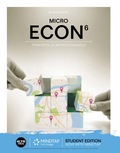
Concept explainers
A
To Determine:
The most efficient scale of production when Q= 65 is to be determined.
Concept Introduction:
Efficient scale of production: is defined as the point which is the lowest and where the firm (or plant) can produce so that the long run average costs are minimized.
B
To Determine:
The most efficient scale of production when Q= 75 is to be determined.
Concept Introduction:
Efficient scale of production: is defined as the point which is the lowest and where the firm (or plant) can produce so that the long run average costs are minimized.
C
To Determine:
The long run average cost is to be traced on the diagram.
Concept Introduction: The long run average cost curve is the lowest cost curve for each output level.
Trending nowThis is a popular solution!

- how can a sugery drink like pepsi have a tax rise and not loose its customers ?arrow_forwardIs competition good for business? Is it good for consumers? Explain why or why not for botharrow_forwardInstructions:- Need to do in assembly language. Submit your DOC file with all explanation, also submit your code file. no chatgpt pls no plagirism plsarrow_forward
- 'producing more goods and services lowers environmental quality' is not the correct answer.arrow_forwardA movement along an economy's production possibility frontier with output on one axis and environmental quality on the other shows that: technological improvements may lead to a sustainable economy with higher consumption in the future and better an improved environment. producing more goods and services lowers environmental quality. producing more goods and services raises environmental quality. a high use of natural resources to produce more goods and services today may lead to an unsustainable economy with lower consumption in the future.arrow_forwardDon't used Ai solutionarrow_forward
- = - 12. Recall the market setting in Question 3, where the demand curve is P = 10 – 2Q, and mar- ginal cost is c 2. Now suppose that two firms, numbered 1 and 2 compete over this de- mand curve. They produce quantities Q₁ and Q2, hence total output is given by Q = Q1+Q2. The best response function of firm 1 to firm 2, labeled Q₁ = B₁ (Q2) is given by (a) 2-2Q2 - 4 (b) 2-Q2 (c) 2 – 02 Q2 Q2 (d) 2- (e) 2-Q 4 13. In the previous question, the Cournot-Nash equilibrium quantity produced by each firm is (a) 1 (d) 2 (b) 3 2 (e) 52 (c) 43 3arrow_forward2. Sweet taxes make the world sweeter! According to a study conducted by the World Health Organization, noncommunicable diseases, such as heart disease, cancer, diabetes, chronic lung disease, and stroke, are the main leading causes of deaths—almost 90% worldwide. These diseases also have social and economic costs. Cardiovascular diseases, for example, cost the economy of the European Union about 210 billion Euro in 2015. One method some European countries adopted to try to reduce the death rate from those leading causes was to impose high taxes on sugar-sweetened beverages. Assume that your next president loves the idea of sugar taxes and proposes a 30% tax on all sugary beverages in the country. And assume you are a marketing manager at a company that makes sugary soft drinks. The owner of the company heard the news and came to you for advice and asked you the following questions: So, buddy, should I be worried about our business if this sugar tax policy is implemented? Why? How do…arrow_forward3. The world is more beautiful with just a bit of makeup. Your friend Nora is an artist, and she loves makeup, so she decided to become a beautician. She recently began recording videos of herself applying makeup to others and posting those videos on social media. She typically charges about $250 for full facial makeup for special occasions like weddings, engagement parties, graduation parties, and so forth. Her work is great, and her videos made her famous on social media outlets, and now she has over 500,000 followers. The demand for her services has risen. People have to book her months in advance if they want her to do their makeup. She was excited about her success, and she wants to take advantage of it, so she wants to learn more about her opportunities and has texted you the following questions: Now people want my services so badly, do you think I should raise my prices from $250 to $500 to make more revenue (sales)? Or should I reduce my price to $150? Please educate me on…arrow_forward
- Don't used Ai solution and hand raitingarrow_forwardDiscussion - Why are planning and organizing important to an organization's success? Requirement: Include Introduction, Body, and Conclusion. Your initial Discussion posting should be at least 150 words in length. Be sure to include a related Title, at least two different citations and references to support your statementarrow_forward25 Replies (14) ☐ : Week 7 Discussion: Elevator Pitch Prepare an elevator pitch you would use to present yourself at a networking event. Introduce yourself, talk about your professional and/or educational background, and mention what your career goals are. Post a video recording of yourself giving your elevator pitch (1-2 minutes). Then, watch your classmates elevator pitches. Reply to at least one other student and let them know what positive public speaking skills they successfully implemented.arrow_forward

 Essentials of Economics (MindTap Course List)EconomicsISBN:9781337091992Author:N. Gregory MankiwPublisher:Cengage Learning
Essentials of Economics (MindTap Course List)EconomicsISBN:9781337091992Author:N. Gregory MankiwPublisher:Cengage Learning Principles of Economics 2eEconomicsISBN:9781947172364Author:Steven A. Greenlaw; David ShapiroPublisher:OpenStax
Principles of Economics 2eEconomicsISBN:9781947172364Author:Steven A. Greenlaw; David ShapiroPublisher:OpenStax Microeconomics: Private and Public Choice (MindTa...EconomicsISBN:9781305506893Author:James D. Gwartney, Richard L. Stroup, Russell S. Sobel, David A. MacphersonPublisher:Cengage Learning
Microeconomics: Private and Public Choice (MindTa...EconomicsISBN:9781305506893Author:James D. Gwartney, Richard L. Stroup, Russell S. Sobel, David A. MacphersonPublisher:Cengage Learning Economics: Private and Public Choice (MindTap Cou...EconomicsISBN:9781305506725Author:James D. Gwartney, Richard L. Stroup, Russell S. Sobel, David A. MacphersonPublisher:Cengage Learning
Economics: Private and Public Choice (MindTap Cou...EconomicsISBN:9781305506725Author:James D. Gwartney, Richard L. Stroup, Russell S. Sobel, David A. MacphersonPublisher:Cengage Learning





